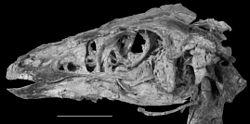Sinornithomimus dongi
|
Sinornithomimus Temporal range: Late Cretaceous, 92 Ma |
|
|---|---|
 |
|
| Skull of specimen IVPP−V11797−10 | |
| Scientific classification | |
| Kingdom: | Animalia |
| Phylum: | Chordata |
| Clade: | Dinosauria |
| Order: | Saurischia |
| Suborder: | Theropoda |
| Clade: | †Ornithomimosauria |
| Family: | †Ornithomimidae |
| Genus: |
†Sinornithomimus Kobayashi & Lü, 2003 |
| Species: | †S. dongi |
| Binomial name | |
|
Sinornithomimus dongi Kobayashi & Lü, 2003 |
|
Sinornithomimus is a genus of ornithomimid theropod dinosaur found in 1997, in the early Late Cretaceous strata of the Ulansuhai Formation located at Alshanzuo Banner, Nei Mongol Autonomous Region, Northern China.
The first fossil remains of Sinornithomimus were uncovered by Dong Zhiming near Ulan Suhai in the context of the Mongol Highland International Dinosaur Project. They contained at least fourteen skeletons found in close association, nine of which are nearly complete and relatively uncrushed. The find consisted of three sub-adult to adult specimens and eleven juveniles. The unweathered state of the bones, preserved in siltstone interspersed with layers of clay and the absence of evidence for post-mortem movement, argue for a catastrophic event that killed all the individuals present in the find simultaneously and instantaneously.
The type species Sinornithomimus dongi was named and described by Yoshitsugu Kobayashi and Lü Junchang in 2003. The generic name means “Chinese bird mimic” while the specific descriptor honours Dong as the discoverer of the fossils. The holotype, IVPP-V11797-10, is one of the subadult skeletons. The other skeletons have been assigned as paratypes.
A second expedition in 2001 at the same site led to the discovery of another fossilized herd of thirteen juveniles and subadults of Sinornithomimus. Their positioning suggest that they died together and over a short interval, likely after having become mired in the mud of a drying waterhole. The second discovery also largely consisted of nearly intact exemplars making Sinornithomimus the most completely known ornithomimid.
...
Wikipedia
